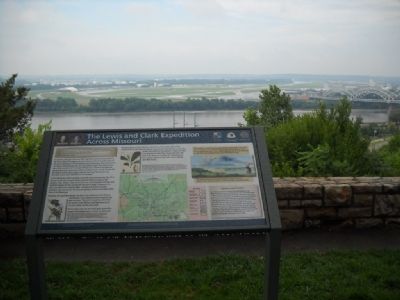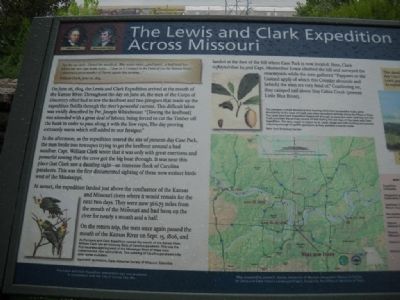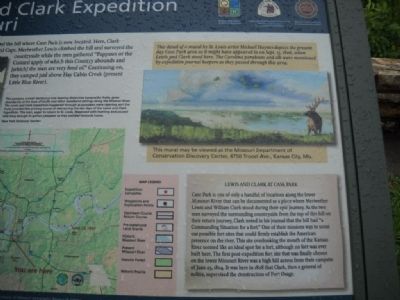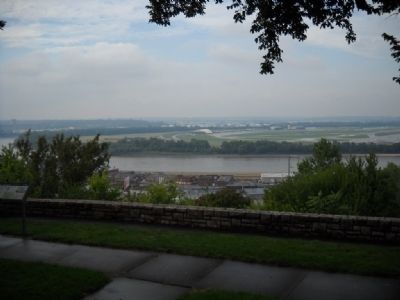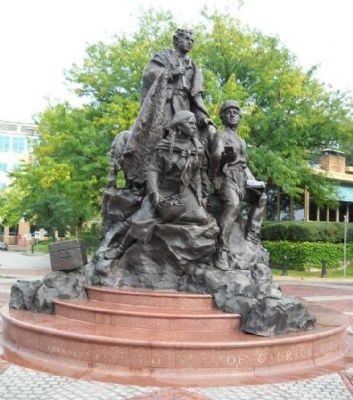Quality Hill in Kansas City in Jackson County, Missouri — The American Midwest (Upper Plains)
Lewis and Clark Expedition Across Missouri
Inscription.
“we Set out early… Passed the mouth of … Blue water river…[and later]… a bad Sand bar, where our two rope twice…. Came to and Camped in the Point above the Kansas River. I observed a great number of Parrot queets this evening…”
William Clark, June 26, 1804
On June 26, 1804, the Lewis and Clark Expedition arrived at the mouth of the Kansas River. Throughout the day on June 26, the men of the Corps of Discovery often had to tow the keelboat and the two pirogues that made up the expedition flotilla through the river’s powerful current. This difficult labor was vividly described by Pvt. Joseph Whitehouse: “[Towing the keelboat] was attended with a great deal of labour, being forced to cut the Timber off the bank in order to pass along it with the Tow rope, The day proving extreamly warm which still added to our fataigue.”
In the afternoon, as the expedition neared the site of present-day Case Park, the men broke two towropes trying to get the keelboat around a bad sandbar. Capt. William Clark wrote that it was only with great exertions and powerful rowing that the crew got the big boat through. It was near this place that Clark saw a dazzling sight – an immense flock of Carolina parakeets. This was the first documented sighting of these now extinct birds west of the Mississippi.
At sunset, the expedition landed just above the confluence of the Kansas and Missouri rivers where it would remain for the next two days. They were now 366.75 miles from the mouth of the Missouri and had been on the River for nearly a month and a half.
On the return trip, the men once again passed the mouth of the Kansas River on Sept. 15, 1806, and landed at the foot of the hill where Case Park is now located. Here, Clark reported that he and Capt. Meriwether Lewis climbed the hill and surveyed the countryside while the men gathered “pappaws or the Custard apple of which this Country abounds and [which] the men are very fond of.” Continuing on, they camped just above Hay Cabin Creek (present Little Blue River.)
Lewis and Clark at Case Park
Case Park is one of only a handful of locations along the lower Missouri River that can be documented as a place where Meriwether Lewis and William Clark stood during their epic journey. As the two men surveyed the surrounding countryside from the top of this hill on their return journey, Clark noted in his journal that the hill had “a Commanding Situation for a fort.” One of their missions was to scout out possible fort sites that could firmly establish the American presence on the river. This site overlooking the mouth of the Kansas River seemed like an ideal spot for a fort,
although no fort was ever built here. The first post-expedition fort site that was finally chosen on the lower Missouri River was a high hill across from their campsite of June 23, 1804. It was here in 1808 that Clark, then a general of militia, supervised the construction of Fort Osage.
(picture of Carolina Parakeet)
As the Lewis and Clark Expedition neared the mouth of the Kansas River, William Clark saw an immense flock of Carolina parakeets. This was the first recorded sighting west of the Mississippi River of these once numerous but now extinct birds. This painting of Carolina parakeets is by John James Audubon.
Used with permission, State Historical Society of Missouri, Columbia
(picture of PawPaw)
The pawpaw, a small deciduous tree bearing distinctive bananalike fruits, grew abundantly at the base of bluffs and other woodland settings along the Missouri River. The Lewis and Clark Expedition happened through as pawpaws were ripening and the fruits provided the primary source of diet during the last days of the Lewis and Clark Expedition. The men, eager to return to St. Louis, dispensed with hunting and paused only long enough to gather pawpaws as they paddled towards home.
New York Botanical Garden
(Mural of Case Park)
This detail of a mural by St.
Louis artist Michael Haynes depicts the present day Case Park area as it might have appeared in on Sept. 15, 1806, when Lewis and Clark stood here. The Carolina parakeets and elk were mentioned by expedition journal keepers as they passed through this area.
This mural may be viewed at the Missouri Department of Conservation Discovery Center, 4750 Troost Ave., Kansas City, Mo.
(map of Missouri River)
Map prepared by James D. Harlan, University of Missouri Geographic Resources Center for Lewis and Clark Historic Landscape Project, funded by the Office of Secretary of State.
Topics and series. This historical marker is listed in these topic lists: Animals • Exploration. In addition, it is included in the Lewis & Clark Expedition series list. A significant historical date for this entry is June 26, 1632.
Location. 39° 6.311′ N, 94° 35.532′ W. Marker is in Kansas City, Missouri, in Jackson County. It is in Quality Hill. Marker is at the intersection of 8th Street and Jefferson Street, on the right when traveling west on 8th Street. This marker is at the north part of a circle parking area. Parking may be a premium during business hours M-F. Touch for map. Marker is at or near this postal address: 611 W 8th Street, Kansas City MO 64105, United States of America. Touch for directions.
Other nearby markers. At least 8 other markers are within walking distance of this marker. The French and the Lewis & Clark Expedition (a few steps from this marker);
Etienne Veniard - Sieur de Bourgemont (a few steps from this marker); Lewis and Clark (within shouting distance of this marker); James Pendergast (about 300 feet away, measured in a direct line); Darby Trotter Spirit Mall (about 800 feet away); Frontier Railroads in Kansas City (about 800 feet away); Ed Hogan (approx. 0.2 miles away); Slavery in Kansas City (approx. 0.2 miles away). Touch for a list and map of all markers in Kansas City.
More about this marker. This is a very nice and historic overlook of the Missouri River and of the Downtown Airport.
Also see . . .
1. Discovering Lewis & Clark. Website from the Fort Mandan Foundation with resources about the expedition. (Submitted on January 23, 2010, by Thomas Onions of Olathe, Kansas.)
2. Lewis & Clark Trail. Website from the National Park Service. (Submitted on January 23, 2010, by Thomas Onions of Olathe, Kansas.)
3. Case Park. Information from Lewis & Clark Trail on Case Park (Submitted on January 23, 2010, by Thomas Onions of Olathe, Kansas.)
Additional keywords.
Lewis and Clark Expedition
Credits. This page was last revised on February 10, 2023. It was originally submitted on January 23, 2010, by Thomas Onions of Olathe, Kansas. This page has been viewed 4,478 times since then and 37 times this year. Last updated on July 26, 2015, by Michael W. Kruse of Kansas City, Missouri. Photos: 1, 2, 3, 4, 5. submitted on January 23, 2010, by Thomas Onions of Olathe, Kansas. • Bill Pfingsten was the editor who published this page.
